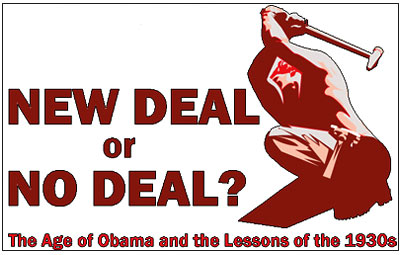IRLE's conference on "New Deal/No Deal?"

In the midst of forecasts of continuing economic woes and congressional gridlock, experts gathered recently at the University of California, Berkeley, to assess what worked and what didn't during the Great Depression-inspired New Deal, the Obama administration's still emerging efforts to ease the Great Recession, and prospects for relief, reform and recovery.
Much of the conference, "New Deal/No Deal? The Age of Obama and the Lessons of the 1930s," is now available online. Hosted on Friday, Oct. 29, by UC Berkeley's Institute for Research on Labor and Employment (IRLE), the program was organized by IRLE director and UC Berkeley labor economist Michael Reich, also co-author of the just-released "Labor in an Era of Globalization," and Richard Walker, a UC Berkeley geography professor and the head of IRLE's California Studies Center.

The institute was founded in 1945 and is home to over 60 UC Berkeley professors from a variety of fields who are researching elements of labor and employment relations in the United States and around the world. The campus also is home to several noted economic historians of the Great Depression who participated in the conference.
Kim Voss, chair of UC Berkeley's sociology department and an expert on labor and social movements, said two views of the role of government during the New Deal – and today –can be seen in two highly visible structures on the UC Berkeley campus.
One is the Old Art Gallery near the center of campus. The gallery's, eastern wall features two colorful mosaic murals installed as part of a New Deal work program in 1936 and 1937. But visitors to the campus's western entrance on Oxford Street, Voss said, are welcomed by an elegant new gate, adorned with a plaque explicitly proclaiming that no state funds were spent on its construction.
Reich and Walker said they organized "New Deal/No Deal?" in part to develop research topics for a follow-up conference in 2011.
That event will further evaluate the lessons of the New Deal and its massive public works programs; contemporary efforts to regulate monetary policy and bail out banks, but not homeowners; the chances for meaningful regulation of the financial industry; changes in how our labor markets are functioning, and how economic recovery programs might fare in a political fight over budget deficits.
The organizers and other participants said government played a crucial role in digging the country out of the Great Depression, and must be a major force in doing so again. "But people have forgotten what government can do," lamented Walker.
Gray Brechin, director of California's Living New Deal Project at the IRLE, said the beneficiaries of the New Deal's "vast and largely indispensible legacy of buildings, infrastructure and parks ... almost immediately took it for granted and forgot its origin."
For example, few people are aware that the New Deal's Work Progress Administration planted 15,000 street trees in the city of Berkeley, erected the San Francisco-Oakland Bay Bridge and constructed an "invisible archipelago" of libraries and other buildings devoted to education that Brechin said "we were persuaded that we didn't have to pay to maintain or expand."
Other conference participants included UC Berkeley economists Barry Eichengreen, who spoke on the American situation in light of a global economic imbalance; Bradford J. DeLong, who noted commercial/investment banking didn't exist during the Great Depression; John Quigley, an expert on the housing market; Jesse Rothstein, speaking on the debate over how extending unemployment benefits affects the labor market; and former U.S. Labor Secretary and public policy professor Robert Reich, who said congressional gridlock through at least 2012 will leave economic solutions largely up to the Federal Reserve Bank and its chief, Ben Bernanke.
Also participating in the event were economist Dean Baker of the Washington, D.C.-based Center for Economic Policy Research, who spoke about bailouts and financial reform; Robert Johnson, a senior fellow and director of the Institute for New Economic Thinking; Doug Henwood of the Left Business Observer, and UC Berkeley sociologists Neil Fligstein, Margaret Weir and Voss.
Weir discussed her own research on the transformation of federalism, noting that the political structure during the New Deal's early days was simpler and more accessible than today, making it easier for the Roosevelt administration to garner key state and local support for its work projects.
Other conference panelists with insights on the New Deal included Kirstin Downey, author of "The Woman Behind the New Deal: The Life of Frances Perkins, FDR's Secretary of Labor and His Moral Conscience" (2009). She said that Perkins, a critical force behind the 40-hour work week, Social Security, national health insurance and banning child labor, would have conceded that New Dealers didn't "solve" the Great Depression, but would have argued that their projects were essential to just keep people going.
Downey was joined on a panel by Jason Scott Smith, a history professor at the University of New Mexico and author of the prize-winning "Building New Deal Liberalism" (2006). The book explores policies around the New Deal, which devoted two-thirds of its revenues to public works and created 1.2 million jobs a year when the national jobless rate stood at just under 25 percent.
A staff member of the president's bipartisan Financial Crisis Inquiry Commission, Downey said the current economic crisis may retain the recession label, but it "looks a lot like a depression to me."
"If we didn't have Social Security, where would we be?" she asked. "If we didn't have unemployment insurance, where would we be? Let's see where the other Frances Perkinses are out there."
For More Information:
IRLE Conference: http://irle.berkeley.edu/conference/2010/
Old Art Gallery's Mosaic Murals: https://livingnewdeal.org/projects/old-art-gallery-murals-berkeley-ca/
California's Living New Deal Project: https://livingnewdeal.org/
